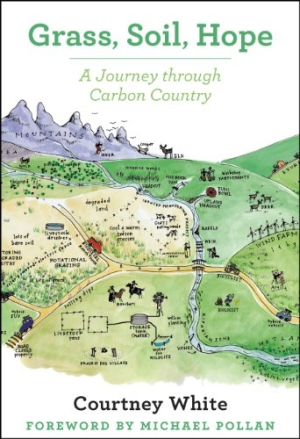Grass, Soil, Hope
A Journey through Carbon Country
Optimism about scientific observations and what people can do to improve the environment makes this book inspiring.
In Grass, Soil, Hope: A Journey through Carbon Country, Courtney White provides a compelling and practical account of how carbon—an essential element and building block of life—may hold the answer to many pressing issues. Smart land use that captures carbon in the soil can enhance the climate, plant and animal diversity, our waterways, the quality of our food, and our quality of life in general. An engaging storyteller, White describes farmers, ranchers, scientists, artists, and many “everyday” people who are putting these ideas into action.
We all live in carbon country, White says, and we all make decisions that can have a positive impact on the health of our planet. White begins with an accessible overview of the chemistry of carbon molecules, photosynthesis, the carbon cycle, and factors that influence the amount of carbon fixed in the soil. Much of the book focuses on food production on farms and ranches, but it also considers individuals in suburban and urban settings using the same principles, including coastal ecologists studying the New Orleans river delta, a water architect creatively restoring creeks and watersheds in New Mexico, and a rooftop farmer in New York City pioneering urban agriculture.
White is a former activist who dropped out of the “conflict industry” to “build bridges” between ranchers, conservationists, public land managers, scientists, and others. His optimism infuses this book. Noting that carbon is often cast as the “bad guy” in discussions about climate change and fossil fuels, White reframes the issue and suggests that the villain may actually be the hero.
In chapters on ranching and farming, White draws extensively—and convincingly—on research to demonstrate how informed land use improves soil quality by “sequestering” carbon. For instance, in promoting no-till farming, he cites emerging science on the symbiotic link between plant roots and a soil fungus known as mycorrhiza that helps to fix carbon and significantly improve soil fertility.
Elsewhere, chapters on urban farming, watershed management, and similar efforts are less quantitative and rely instead on observation and anecdote, but they are just as thought-provoking. He suggests the dramatic decline in beaver populations may be a key cause for dwindling water supplies in the West, and he profiles naturalists working to encourage beaver dams to improve the quality of waterways. White has crafted a challenging, engaging narrative that will compel many readers to reconsider the link between our soil and the future of our planet.
Reviewed by
Kristen Rabe
Disclosure: This article is not an endorsement, but a review. The publisher of this book provided free copies of the book to have their book reviewed by a professional reviewer. No fee was paid by the publisher for this review. Foreword Reviews only recommends books that we love. Foreword Magazine, Inc. is disclosing this in accordance with the Federal Trade Commission’s 16 CFR, Part 255.

